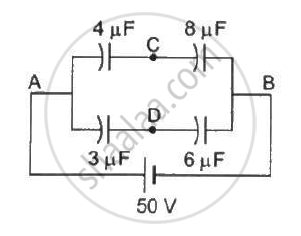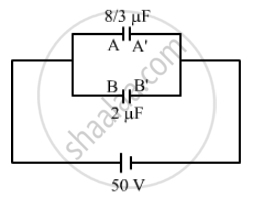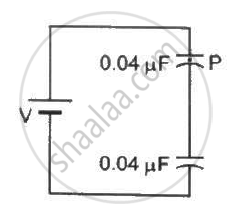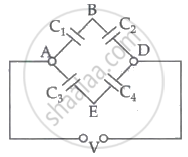Advertisements
Advertisements
Question
Take the potential of the point B in figure to be zero. (a) Find the potentials at the points C and D. (b) If a capacitor is connected between C and D, what charge will appear on this capacitor?

Solution

(a) The capacitance of the two rows connected in parallel is given by
`C_1 = (4 xx 8)/(4+8) = 8/3 "uF" and C_2 = (3 xx 6)/(3+6) = 18/9 "uF" = 2 "uF"`
As the two rows are in parallel, the potential difference across each row is the same and is equal to 50 V.
The charge on the branch ACB with capacitance `8/3 "uF"` is given by
`Q = (8/3 "uF") xx (50 V) = 400/3 "uC"`
The charge on the branch ADB with capacitance `2 "uF"` is given by
`Q = C xx V`
`Q = 2 "uF" xx 50 = 100 "uC"`
The potential at point D is given by
`V_D = q/C_1 = (100 "uC")/(6 "uF")`
`V_D = 50/3 V`
Similarly, the potential at point C is given by
`V_c = 50/3 V`
(b) As the potential difference between points C and D is zero, the bridge remains balanced and no charge flows from C to D. If a capacitor is connected between points C and D, then the change on the capacitor will be zero.
APPEARS IN
RELATED QUESTIONS
A point charge +Q is placed at point O, as shown in the figure. Is the potential difference VA – VB positive, negative or zero?

The particle P shown in figure has a mass of 10 mg and a charge of −0⋅01 µC. Each plate has a surface area 100 cm2 on one side. What potential difference V should be applied to the combination to hold the particle P in equilibrium?

Show that electric potential at a point P, at a distance 'r' from a fixed point charge Q, is given by:
`v=(1/(4pi∈_0))Q/r`.
Answer the following question.
The magnitude of the electric field (in NC – 1) in a region varies with the distance r(in m) as
E = 10r + 5
By how much does the electric potential increase in moving from point at r = 11 m to a point at r = 10 m.
Electric potential energy of two point charges q and q0 is ________.
If a positive charge moves opposite to the direction of the electric field, the field does _______ work on charge and potential energy ________.
A cube of metal is given a positive charge Q. For this system, which of the following statements is true?
A positively charged particle is released from rest in a uniform electric field. The electric potential energy of the charge ______.
-
The metal plate divides the capacitor into two capacitors connected in parallel to each other.
-
The metal plate divides the capacitors into two capacitors connected in series with each other.
-
The metal plate is equivalent to a dielectric of zero dielectric constant.
An electric dipole of moment `vec"p"` is placed in a uniform electric field `vec"E"`. Then ______.
- the torque on the dipole is `vec"p" xx vex"E"`
- the potential energy of the system is `vec"p" * vec"E"`
- the resultant force on the dipole is zero.
Choose the correct option.
If a conductor has a potential V ≠ 0 and there are no charges anywhere else outside, then ______.
The force acting on a particle in one dimension is F = ax - 2xβ3. The corresponding potential energy V(x), assuming V(0) = 0 is given by ______.
If a conductor has a potential V ≠ 0 and there are no charges anywhere else outside, then ______.
- there must be charges on the surface or inside itself.
- there cannot be any charge in the body of the conductor.
- there must be charges only on the surface.
- there must be charges inside the surface.
The electric potential on the axis of an electric dipole at a distance ‘r from it’s centre is V. Then the potential at a point at the same distance on its equatorial line will be ______.
The potential difference between points B and E of the circuits is ______.

